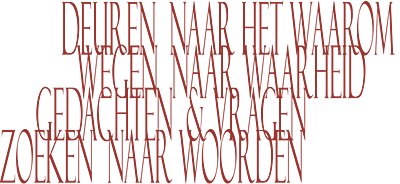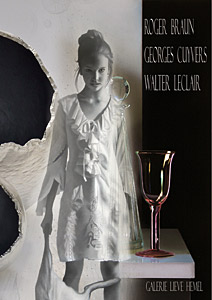Wegen naar het Waarom - Gates to Why
  Omdat ik me nogal eens verbaas over de dwangmatige invulling van de conceptgedachte in de kunst (heeft niet alles wat mensen creëren vanzelf al een concept, en hoe nadrukkleijk moet een concept dan zijn om mee te mogen tellen?) zag ik in deze tentoonstelling een aardige aanleiding om daar een paar woorden aan te wijden. De maatschappelijke relevantie van stillevens heb ik al eens ter sprake gebracht. Wie wil vindt een hond om de stok mee te slaan, en het zal u zodoende niet verbazen dat ik nu juist niet naar een stok wilde zoeken. Ik voelde me in de voorbereidende overpeinzingen gestimuleerd door een compilatie van modellen *) waarin uitputttend wordt beschreven hoe men op uiteenlopende manieren kunst moet bekijken. In elf methode's komen voor het overgrote deel rationele criteria aan bod, en slechts sporadisch, bijna als per ongeluk, het associatieve en vooral het moeilijk of niet verwoordbare, maar juist fascinerende in kunst. In het model van David Perkins - The Intelligent Eye - lees ik dat het voor het denken van groot belang is gericht naar kunst te kijken, en dat gerichte kijken kun je leren. Doe je dat niet, dan wordt uw intelligentie niet ontwikkeld. Zou het, vraag ik mij al reflecterend af, helpen als kunstenaars dat vantevoren ook doen, of althans, dat Perkins dat denkt, of moet de kunstenaar zich daarvan onthouden en juist gehaast en chaotisch met zijn of haar gedachtengoed omgaan opdat de toeschouwer pas na een cursus iets aan die bevlogenheid heeft? Maar, ik moet een riem onder het hart van de vorsers steken. Als kunsthistoricus ben je voor eeuwig afgesneden van de emotionele beleving van vrijwel alles uit vroeger tijden. Er blijft weinig anders over dan de beschrijvende en analyserende aanpak. En eigenlijk, al staat u naast een kunstenaar op het moment dat die zijn meesterwerk concipieert, en ik neem even aan dat u dan even niks mag vragen, dan staat u nog steeds met een mond vol tanden als u als ervaringsdeskundige iets later ondervraagd zou worden over de gevoelsmatige aspecten van het meesterwerk. Om dat te maskeren is in de kunst van tegenwoordig Het Concept een tweede leven toebedeeld. Tot mijn verrassing kwam ik onlangs zelfs de classificatie Conceptueel Realisme tegen. Ik ben er nog niet uit of dat een pleonasme of een utopie is. Het concept in letterlijke zin is ooit ten tonele gevoerd in de loop van een proces van kunstzinnige vernieuwing, die de balorigheid moest verhullen waarmee niet door materialen en handvaardigheid geïnspireerde kunstenaars hun bestaansrecht wilden bewijzen. Waaraan ik niet eens schoorvoetend toevoeg dat in de kunst alles mag, waaronder verheerlijking van idealen, zelfs dat iets moet. Laat nou juist de drie kunstenaars van deze tentoonstelling naar hartelust verwoorden wat hen bezielt, filosoferen over het ontstaan van hun schilderijen, respectievelijk zilveren sculpturen, of die toetsen aan aan vigerende opvattingen. Op www.lievehemel.nl treft u fragmenten uit hun uitspraken en geschriften aan, maar de titels van hun kunstwerken geven u al een voorproefje. Waaruit maar weer eens blijkt dat vaste maatstaven in de borrelende kookpot van het kunstbeleven geen bestaansrecht hebben. Dat komt eigenlijk mooi uit, want wat ontbreekt aan mijn exposé over de hedendaagse verklaringsdrift is dat, net als wetenschappers die tot hun laatse snik zullen zoeken naar de de laatste oorzaak, wij nooit ten prooi mogen vallen aan de fatalistische neiging ons neer te leggen bij onze fundamentele ontoereikendheid. Op het potsierlijke af - ik doel nu op mijzelf - zullen wij moeten blijven zoeken naar verklaring en inzicht, en kan ik dientengevolge niet anders dan mijn neiging tot het benadrukken van het onverwoordbare onderdrukken en zuchtend, maar nietttemin gretig, telkens weer mijn pen pakken voor de zoveelste ultieme poging. *) Overzicht Kunst Analyse Modellen, 2001, M.T.A. van de Kamp/W.P.M. Cuijpers (Universiteit van Amsterdam - Interfacultaire Lerarenopleidingen) Top   Because I tend to marvel at the compulsive elaboration of conceptualism in the arts (doesn’t every single thing people create inadvertently come with a concept of its own, and how prominent must a concept be in order for it to be taken seriously?), I realised that this exhibition offered a charming opportunity for me to devote a few words to the subject. I have in the past broached the subject of the societal relevance of still lifes. Any dog will do to beat a stick as long as one is keen enough, and so I know it won’t come as a surprise to you when I tell you that it was never a stick I was looking for. While going through my preparatory musings I felt encouraged by a compilation of models that exhaustively describe how art should be looked at in a variety of ways. The eleven methods that are presented are overwhelmingly made up of rational criteria, with only the odd sprinkling – sporadically and quasi coincidentally – of the associative and, most particularly, of that which all but defies articulation and yet is precisely what is so enthralling about art. David Perkins’s model – The Intelligent Eye – tells me that it is of great importance where thought is concerned that one should look at art in a focused manner. This, Mr Perkins urges, is something one can learn, and if one can’t be bothered, this will inevitably result in one’s intelligence remaining stunted. Would it be helpful, this made me wonder while I was reflecting away, if artists did the same thing in advance, or in any event if Mr Perkins could be convinced that this was what it was they were doing, or should they steer clear and deal with their thoughts in as slapdash and poorly organised a manner as possible, in order for the spectator to be able to benefit from all this animation only after he or she had completed the appropriate training course? And yet the explorers deserve a leg up. As an art historian one is destined to remain cut off from the emotional experience of practically anything from the past. The descriptive cum analytical approach is virtually all that is left. But let’s face it, even if you were standing next to an artist at the very moment he was conceiving his magnum opus (it being my assumption that this would not be the most appropriate moment for you to start asking him questions), as a hands-on expert you’d be no less stymied if they subsequently started quizzing you about the emotional aspects of the masterpiece. The Concept has been given a new lease on life in today’s art as a way of masking this. Not long ago I surprisingly chanced upon Conceptual Realism as a separate grouping. I haven’t yet decided whether this would be a pleonasm rather than a pipe dream or whether it’s the other way around. Many moons ago The Concept in a literal sense was presented in the course of a process of artistic innovation designed to cover up the waywardness utilised as raison d’être by artists unable to find inspiration in materials or craftsmanship. To which I would add without so much as a hint of reluctance that anything goes in the arts including the glorification of ideals, even to the point where something is proclaimed to be a must. It’s no coincidence that the three artists featured in this exhibition express to their heart’s content what inspires them, philosophising about the origin of their paintings or silver sculptures or testing these against prevailing opinions. Excerpts from their spoken and written comments are available at www.lievehemel.nl, but you only need to look at the titles of the various works of art to get a taste of what’s in store. Which shows once again that there is no place for fixed benchmarks in the boiling cauldron that is the Artistic Experience. Which is just as well, for what has been missing from my discourse about today’s explanatory drive is that just like scientists who to their dying day will continue looking for the final cause, we must never succumb to the fatalistic tendency of resigning to our fundamental inadequacy. We will have to continue to the point of absurdity (I’m referring to myself now) to look for elucidation and comprehension, and so I cannot but suppress my penchant for stressing that which defies being put into words and with a deep sigh reach for my pen for the umpteenth all-out effort. *) Overview of Models of Artistic Analysis, 2001, M.T.W. van de Kamp/W.P.M. Cuijpers (University of Amsterdam – Interfaculty Teacher Training Institute) |
 |
Top